So close yet so far from western cultures Morocco is a country that has inspired traveler fantasies for decades, alluring frugal backpackers, surfers and families alike to a new culture and different experience altogether. While its capital city (Rabat) and financial capital (Casablanca) have a modern feel and drive most of the country’s economy it is a city in mid-Southwest Morocco that year after year attracts most tourists and visitors because of the wealth of side trips and array of things to do: Marrakech. Founded in 1062 this former imperial city follows the typical layout of most cities in the country, an inner medina (an old fortified city packed with vendors and their stalls) surrounded by modern neighborhoods, can easily be visited on foot and is a fantastic introduction to Berber culture.
Getting to Marrakech
The cheapest and most convenient way to reach Marrakech is via any of the low cost airlines that fly here from several cities in Europe: RyanAir, EasyJet, WizzAir and Vueling are just a few. Flights last around 1.5- 3 hours depending on the country of departure and can cost as little as 20Euros plus tax (around 40) each way! It is also possible to get here by road, crossing the straight of Gibraltar from Spain and driving South along the fairly decent road network.
Where to Stay
There is no lack of accommodation options in Marrakech, ranging from very cheap hostel dorm rooms to affordable riads ( traditional Moroccan houses or palaces with an interior garden or courtyard) all the way to luxury riads and hotels. Prices vary but for around 30 Euros per night you can find clean riads right by the city’s main square with breakfast included-if you’re traveling on a budget there is no reason to go anywhere else and I recommend you don’t as it is here that you’ll find the souks, restaurants and where everything happens ( I stayed at Hotel Cecil, a super clean riad right by Jemaa el-Fnaa costing 25Euros per night breakfast included with the friendliest people I met during my stay in the area)
Things to Do in Marrakech
Jemaa el-Fnaa
Jemma el-Fnaa is a square and market place in the middle Marrakesh’s medina quarter. It remains the main square of Marrakesh, used by locals and tourists, and has been featured in countless movies and books- odds are you’ve seen many times on TV long before you get here. During the day the square has fresh orange juice sellers (at 4 DH they are invigorating and very tasty, I had several of them per day and is one of the best things to do in Marrkech more often than not) and at around 5 pm snake charmers and other performers arrive to set up their stalls and tourist traps. By the time it gets dark the food stalls are in place and it is here that you’ll find yourself dining at some point. While the food is decent and fairly priced most of what is served here includes fried chicken, tagine, and other simple meals in a crowded yet entertaining environment. By now the Chleuh are dancing and Berber storytellers are attracting an audience and requesting money from tourists- they can be very pushy and even rude when it comes to this: remain calm and ignore them when you feel they’re out of their way.
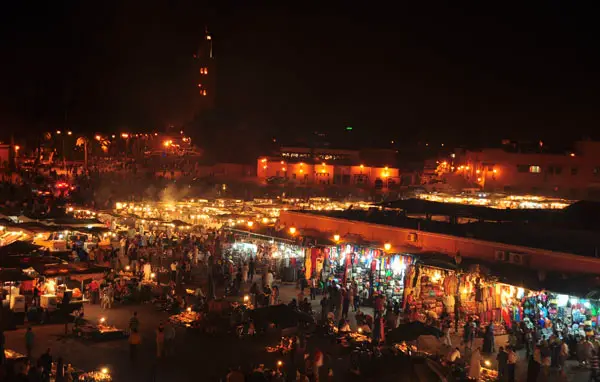
The Souks
Stuff your wallet with Dirhams and Euros before heading here as you are likely to buy something when walking along the traditional North African market catering both for the common daily needs of the locals and tourist trade. You will find can find pretty much anything or interest and lacking thereof, from spectacular carpets to beautiful lamps, t-shirts with dumb slogans, spices, traditional costumes, mirrors decorated with camel bone and perfumes. It’s relatively easy to get somewhat lost as it all looks very similar, but follow the crowd or simply ask for Jemaa el-Fnaa and you’ll be pointed in the right direction. I recommend you take some time when walking around, and consider this more of an attraction than a shopping experience; the souk is a beautiful walk and deserves attention all by itself. By the way, remember to bargain, and bargain hard, when buying anything as they do sell on the expensive side (even for European standards).
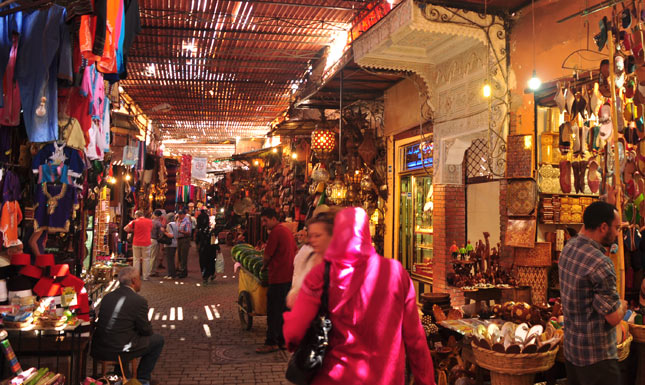
Badia Palace
Just under a ten minute walk East of the square is this palace and its gardens. Built in the 19th century it was meant to be the greatest palace of the time, but it never quite had the charm and splendor required. It was used by Si Moussa, grand vizier of the sultan, for his personal use. There is a 3DH fee to visit.
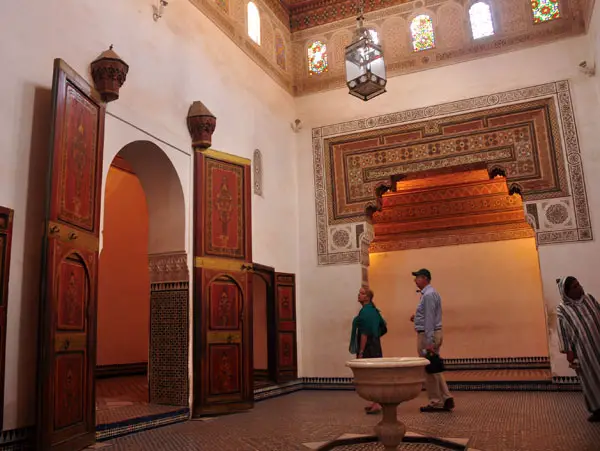
El Badi Palace
These days it consists of the remnants of a palace commissioned by the Saadian Sultan Ahmad al-Mansur in 1578. The palace, which took approximately 25 years to construct, was torn apart in the seventeenth century by the Alaouite Sultan Moulay Ismail, who used the material obtained from El Badi Palace to decorate his own palace in Meknes. The original building is thought to have consisted of 360 rooms, a huge courtyard with a still visible pool richly decorated with Italian marble and large amounts of gold imported from Sudan. There is a mandatory 3DH entrance fee for visiting the palace, and while it might have had its splendor back in its days I found it lacked appeal.
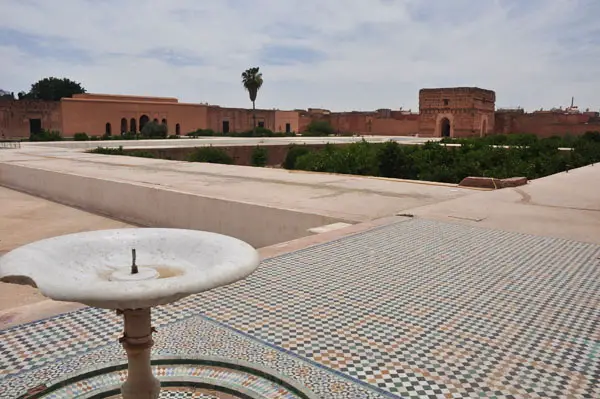
The Spice Market
It’s all about the scents and location. This small market is where you can find all sorts of spices, with store owners willing to give you a walk through and explanation of what they have expecting, as always, that you buy something from them before you leave. It’s an interesting walk and not many tourists visit it despite it being half way between the Bahia and El Badi Palaces, perhaps because it’s somewhat difficult to find- ask around if this is the case.
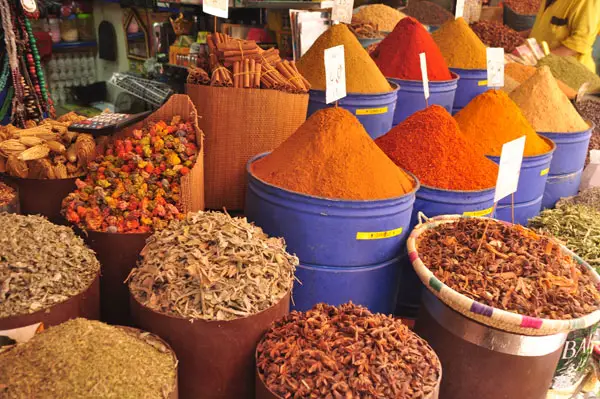
The Tanneries
While this could be a very interesting attraction few independent travelers leave the tanneries excited about the experience, let me explain why. Simply put the tanneries are a couple of walled courtyards where where young boys and men spend their day endlessly shearing at the skins with a blade to get a smooth finish, wading thigh deep into the tubs, to press the skins. Some tubes contained dyes, so the workers legs appeared to be permanently dyed too despite some wore thigh length boots. The skins are also treated with chemicals and and a mixture of natural ingredients (animal urine, pigeon droppings etc!) to soften the skins and remove the fur from the pelts so expect putrid scent and non visually appealing yet humbling and thought provoking visit. After all these are the same skins that are later used to make handbags, puffs, shoes and more. But it’s not this that makes the visit uncomfortable.
If you’re an independent traveler like myself you’ll want to make your way here on your own, easily following a map and at your own pace. However, no matter which was you go as you you approach the area kids will find to asking if you’re going to the tanneries and offering to take you there for free, of course! No matter how many times you say no or walk away you’ll be harassed until you walk with somebody. Once you reach the tanneries there will be a man at the door claiming to be the manager and asking for a ridiculous price to be guided through the tanneries, saying too that part of the money is for the men who work there (yeah right). Bargain hard and expect unfriendly looks but keep your stance. Once the visit is over (which will not take more than 10 or 15 minutes) you’ll be out the door and of course the kid who brought you here for free will ask for money too, and one or two Euros will not make him happy. I followed what seemed the logical route back to Jemaa el-Fnaa on the map and ended up walking across a neighborhood that didn’t seem to happy to see me,with a couple of men shouting me to leave the area. I ignored them, continued taking pictures (not of the people) and filming to eventually reach the North end of the souk.
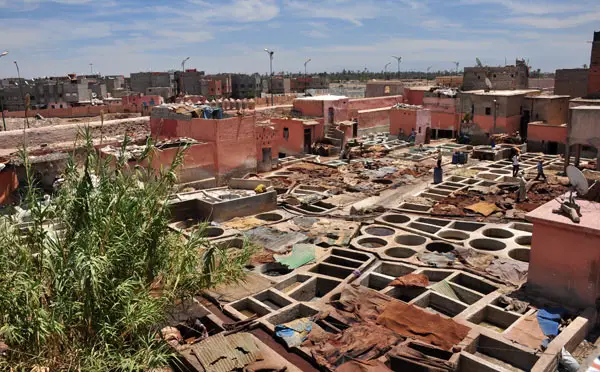
Visit a Hammam
A hammam is basically an arab version of a steam bath, which can be as simple or as luxurious as you want. Traditional hammams (not for tourists) are basically steam rooms which include a skin cleaning rub and are actually quite cheap, at around 80 DH per session. Few travelers venture to these though and most prefer visiting slightly better hammams which offer a more personal experience and follow up with a relaxing massage and/or additional treatments. Moroccans tend to visit hammams in the morning, but because of the heat I visited one late in the afternoon as temperatures outside are lower and the relaxing mood makes sleep much more pleasant.
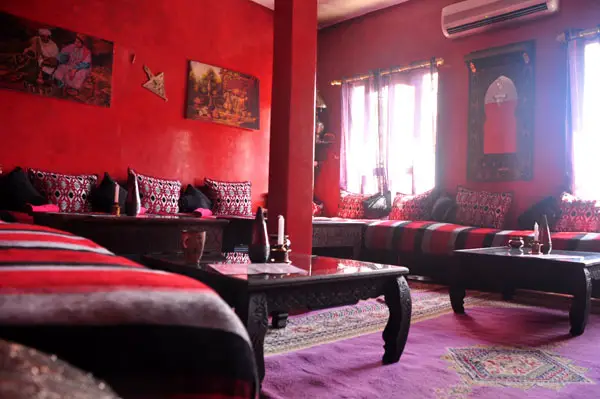
The Saadian Tombs
The mausoleum comprises the remains of about sixty members of the Saadi Dynasty that originated in the valley of the Draa River. There is a 10DH fee to visit them and left the premises with one questions unanswered: why are there so many stray cats here?
Koutoubia Mosque
This is the largest mosque in Marrakech and includes a minaret that dominates the skyline of the city. The minaret is 12.5 m wide and 67.5 m to the tip of the cupola on the lantern, is the mosque’s principal feature and immediately reminded me of the Giralda I visited in Seville, Spain. The minaret, composed of six rooms, one on top of the other, was a great feat of engineering in its day and influenced several subsequent buildings in Morocco. The cupola on top is a symmetrical, square structure topped by a ribbed dome and three golden orbs, which are alleged to have been made from the melted down jewellery of Yaqoub al Mansour’s wife, in penance for her having eaten three grapes during the Ramadan fast.
Madrassa Ben Youssef
Madrassa Ben Youssef is one of the most dazzling examples of Moorish architecture in the world. Founded during the Merinid era in the 14th century and reconstructed by the Saadians in the 16th century, it expanded it to become the largest madrassa in Morocco. The entrance is unremarkable – just another wooden door on a medina street – but it serves to enhance the visual impact upon entering the main courtyard, where a jade green tiled rectangular pool reflects shining marble, carved cedar wood, lace-like stucco, scalloped archways and a blue rectangle of sky above. After the chaos and noise of the streets outside, the madrassa is an unexpectedly elegant and refined sanctuary where 900 students were said to have studied the Qu’ran here at any one time. The madrassa in without a doubt one of the most sophisticated and impressive buildings in Marrakesh, and one of the best things to see in Marrakech that I recommend you visit despite the somewhat expensive 70 DH fee.
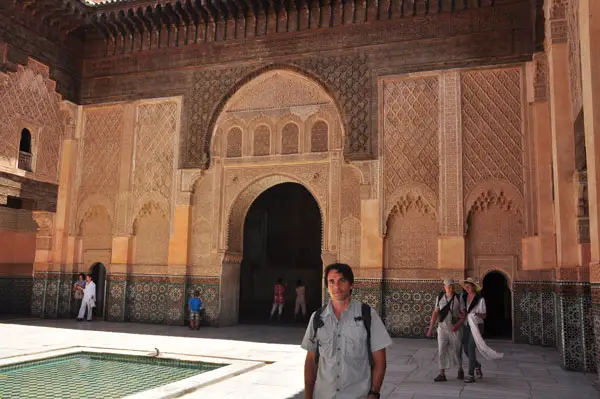
Conclusion
Legendary, hot, active, somewhat invasive yet nonetheless always appealing Marrakesh is a city that will not leave you unnoticed. It has not shortage of things to see and do and is a fantastic example of the non-luxurious Arab world and Muslim culture. The city itself can be easily visited in a couple of days at a leisurely pace, a stay that can be extended if you want to chill out and spend some time at your inexpensive riad absorbing the culture and local way of life.
Resources
Official Marrakech Tourism Website http://www.marrakech.travel/en/html/home

Islamic countries are known for their culture, food and architecture. Their spices are indeed a must buy for all visitors. You were right to say that the place lacked the architectural splendor, which is a basic ingredient of all structures.
Thanks for sharing your thoughts!
Marrakech is a great, exotic city break. I once spent 3 weeks driving around Morocco and I have fond memories. Would certainly recommend.
Hey Jennifer! I’m sure you went all over the place…what area did you like most?
I’m most looking forward to experiencing the souks one day.
They are certainly an interesting experience Erica 🙂
The tanneries experience sounds unpleasant. I wish people realized how much harm they are doing to their tourism industries when they behave that way. Argh!
The spice markets and the palaces look stunning, however!